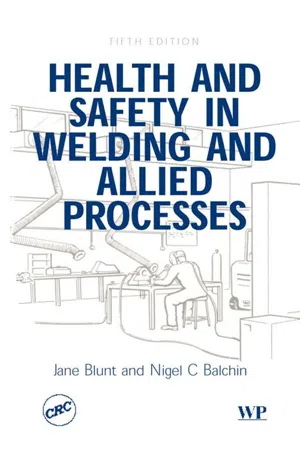1
Setting up the Workplace
In both the United Kingdom and the United States of America, there is a legislative framework that assigns a very large measure of responsibility to employers for the health and safety of their employees. The detailed approach is slightly different and readers need to familiarise themselves with the requirements. Where they have doubts, they should consult the enforcing authorities for advice:
• The Health and Safety Executive (United Kingdom)
• Occupational Safety and Health Administration (United States of America).
The general requirements in the United Kingdom are laid down in the Health and Safety at Work, etc, Act, 1974,1 which places a duty on all employers to ensure as far as is reasonably practicable, the health, safety and welfare of all of their employees while they are at work. Many duties are also extended to those not in their employment but who may be affected by the employer’s undertaking. The Act enabled the making of Regulations, which contain detailed specific requirements, which employers are required to comply with. The basis upon which employers should act is one of risk assessment – where employers must analyse the risks associated with their work activities and implement measures to control those risks.2 Employees are required to cooperate with their employer’s efforts to meet the requirements of the Act and the Regulations.
There are two useful websites where further information may be obtained, Her Majesty’s Stationery Office,3 where the full text of all Statutory Instruments published since 1987 is available to view and print, and the Health and Safety Executive,4 (HSE), where there is a great deal of advice and guidance.
The general requirements in the United States of America are laid down in section 5 of the Occupational Safety and Health Act of 1970,5 which requires employers to furnish each of their employees with employment and a place of employment which are free from recognised hazards that cause or are likely to cause death or serious physical harm to those employees. The Act requires employers to comply with the occupational safety and health standards that it promulgates. The Occupational Safety and Health Administration (OSHA) maintains a website from which access can be gained to Federal Regulations.6 Employees are required to comply with the rules, regulations and orders that apply to them.
The net effect in both countries is that in order to ensure that the workforce remains safe and that the requirements are met, a system is needed to manage safety in the workplace. An efficient system will not only meet the legislative requirements, but is also cost effective in minimising lost time through illness and injury.
The employer should set up a policy for the assurance of health and safety and assign responsibilities for undertaking the many tasks that will need to be carried out. The workplaces will need to be constructed and maintained in good order. The work equipment will need to be fit for its purpose and properly maintained .7 Setting up a safety committee enables worker participation and establishes good communication. Safety rules will be needed and the workforce will need to be trained so that they know what hazards they face, the preventive and protective measures that are needed to avoid the risk of injury or ill health, and how to make the best use of those measures, including personal protective equipment if it is needed.8 An inspection programme will be needed to ensure that the measures are adequate and that tasks are being carried out as required. In many workplaces, there will be a need for some health surveillance and monitoring of key indicators.
The Workplace
First, the prescribed poster should be put up in the workplace. In the UK, this is available from the HSE or good bookshops.9 Alternatively, the prescribed leaflet10 may be distributed to every employee. In the USA, the prescribed poster11 can be downloaded from the government website. The workplace should be in accordance with the provisions of the Workplace Regulations,12 or in the USA, according to the requirements of subparts D and J of 29 CFR 1910.13,14
Indoor workplaces should be kept at a reasonable temperature. A temperature of 16 °C or above is recommended where personnel are undertaking light work, and a minimum of 13 °C where heavy work is undertaken. Measures may need to be taken in hot weather to prevent people from becoming overheated.
Adequate sanitary facilities should be provided, with facilities for washing and drying the hands. The facilities should be kept clean. An area should be set aside, separate from the work area, where food and drink can be consumed without contamination by substances hazardous to health.
Walkways should be marked and kept clear. The walkways should have surfaces tha...
